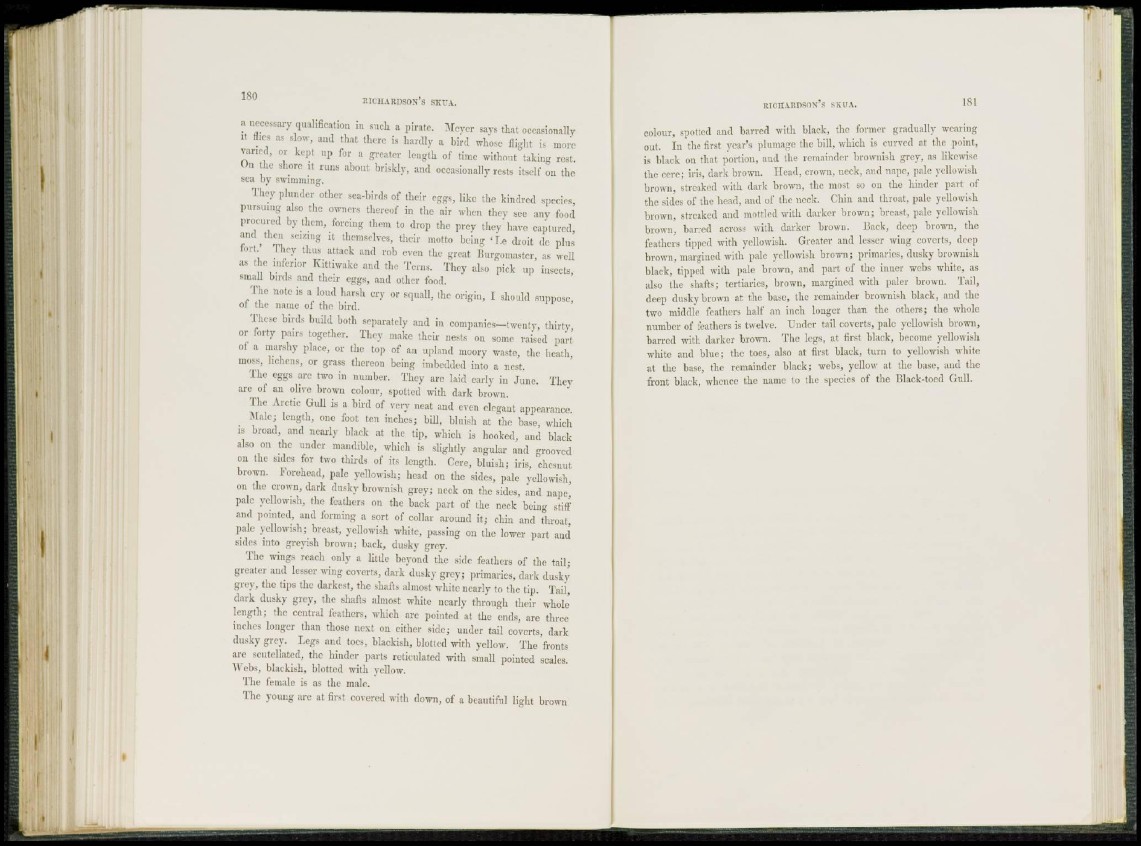
180 RICHARDSON'S SKUA.
«I necessary q u a l i f i c a t i o n in such, a pirate. Meyer says that occasionally
it flies as slow, and that there is hardly a bird whose flight is more
varied, or kept up for a greater length of time without taking rest.
On the shore it runs about briskly, and occasionally rests itself on the
sea by swimming.
They plunder other sea-birds of their eggs, like the kindred species,
pursuing also the owners thereof in the air when they see any food
procured by them, forcing t h e m to drop the prey they have captured,
and then seizing it themselves, their motto being 'T,e droit de plus
fort.' They thus attack and rob even the great Burgomaster, as well
as the inferior Kittiwake and the Terns. They also pick up insects,
small birds and their eggs, and other food.
The note is a loud harsh cry or squall, the origin, I should suppose,
of the name of the bird.
These birds build both separately and in companies-—twenty, thirty,
or forty pairs together. They make their nests on some raised part
of a marshy place, or the top of an upland moory waste, the heath,
moss, lichens, or grass thereon being imbedded into a nest.
The eggs are two in number. They are laid early in June. They
are of an olive brown colour, spotted with dark brown.
The Arctic Gull is a bird of very neat and even elegant appearance.
Male; length, one foot ten inches; bill, bluish at the base, which
is broad, and nearly black at the tip, which is hooked, and black
also on the under mandible, w h i c h is slightly angular aud grooved
on the sides for two thirds of its length. Cere, bluish; iris, chesnul
brown. Forehead, pale yellowish; head on the sides, pale vcllowi-li,
on the crown, dark dusky brownish grey; neck on the sides, and nape,
pale yellowish, the feathers on the back part of the neck being stiff
and pointed, and forming a sort of collar around it; chin and throat,
pale yellowish; breast, yellowish white, passing on the lower part and
sides into grevish brown; back, dusky grey.
The wiugs reach only a little beyond the side feathers of the tail;
greater and lesser wing coverts, dark dusky grey; primaries, dark dusky
grey, the tips the darkest, the shafts almost white nearly to the tip. Tail,
dark dusky grey, the shafts almost while nearly through their whole
length; the central feathers, which are pointed at the ends, are three
inches longer than those next on either side; under tail coverts, dark
dusky grey. Tegs aud toes, blackish, blotted with yellow. The fronts
are scutellated, the hinder parts reticulated with small pointed scales.
Webs, blackish, blotted with yellow.
The female is as the male.
The young are at first covered with down, of a beautiful light brown
RICIIARDSON'S SKUA. 181
colour, spotted and barred with black, the former gradually wearing
out. In the first year's plumage the bill, which is curved at the point,
is black on that portion, aud the remainder brownish grey, as likewise
the cere; iris, dark brown. Head, crown, neck, and nape, pale yellowish
brown, streaked with dark brown, the most so on the hinder part of
the sides of the head, and of the neck. Chin and throat, pale yellowish
brown, streaked and mottled with darker brown; breast, pale yellowish
brown, barred across with darker brown. Back, dee}) brown, the
feathers tipped with yellowish. Greater and lesser wing coverts, deep
brown, margined with pale yellowish brown; primaries, dusky brownish
black, tipped with pale brown, and part of the inner webs white, as
also the shafts; tertiaries, brown, margined with paler brown. Tail,
deep dusky brown at the base, the remainder brownish black, and the
two middle feathers half an inch longer than the others; the whole
number of feathers is twelve. Under tail coverts, pale yellowish brown,
barred with darker brown. The legs, at first black, become yellowish
white aud blue; the toes, also at first black, turn to yellowish white
at the base, the remainder black; webs, yellow at the base, and the
front black, whence the name to the species of the Black-toed Gull.